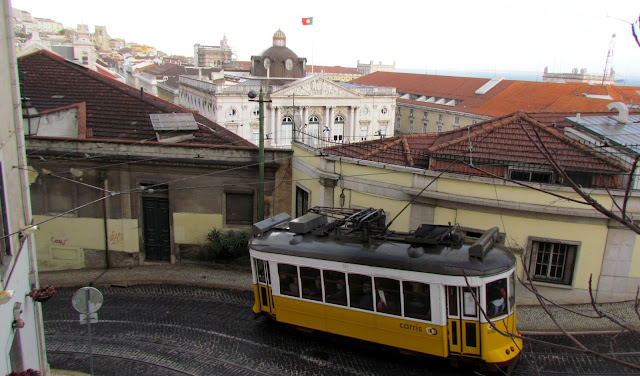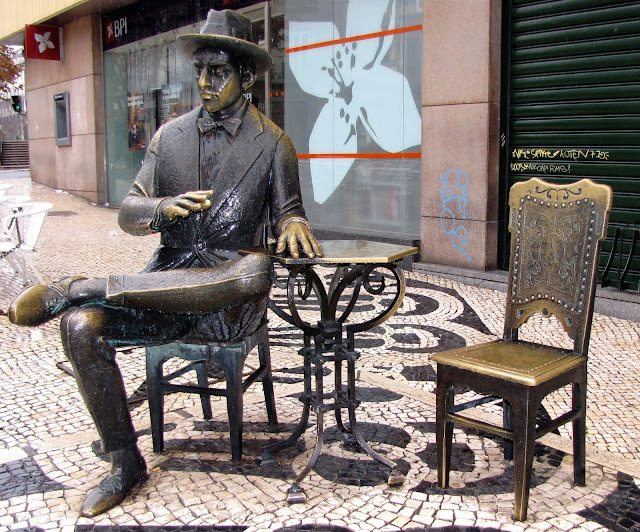Largo do Chiado is a square at the center of the fashionable Chiado neighborhood, an area known for its theaters, shops, bookstores and cafés. This was once the literary center of the city, and it long had a bohemian character.The literary history of Chiado goes far back in time: the neighborhood is said to be named after a 16th-century poet, António Ribeiro, who lived in the area and was nicknamed 'Chiado'.
.JPG)
.JPG)
.JPG)
.JPG)
.JPG)
.JPG)

Statues
A statue of António Ribeiro stands at the center of the Chiado Square. Ribeiro, shown seated, became a Franciscan monk but later renounced monastic life and he moved to a street in Chiado, now the Rua Garrett. Ribeiro is known for his poets and satirical dramas. He was also popular in his time for his imitations of other people.
Several other writers are honored here with statues. A bronze figure of Fernando Pessoa - considered one of the greatest Portuguese writers - is sitting at a table in front of the café Brasileira. The café - now popular with tourists - has a beautiful interior full of character. It was once a favorite meeting place of Pesso and other Lisbon intellectuals. (from aviewoncities.com)
(CHIADO)
"A BRASILEIRA" AND FERNANDO PESSOA
A BRASILEIRA
The Café A Brasileira (The Brazilian Cafe) is one of the oldest and most famous cafésin of the old quarter of Lisbon. Located at 120 Rua Garrett, at one end of the Largo do Chiado (Chiado Square), near the Baixa-Chiado metro stop, ensuring its café and terrace are never empty.
.JPG)
FERNANDO PESSOA ( THE UNIVERSAL POET )
O LIVRO DO DESASOSSEGO
( THE BOOK OF DISQUIET) - NO WORDS
He looked about thirty, thin, rather above average height, exaggeratedly bent over when seated but less so when he stood up, dressed with a certain negligence, which was not entirely negligence. On his pale, uninteresting face an air of suffering did not stir interest, although it was difficult to define what kind of suffering that air — it seemed to suggest several kinds: privation, anguish, and a suffering born from the indifference of having suffered a great deal.
|
| Fernando Pessoa, from the Introduction to The Book of Disquiet, tr. by Alfred MacAdam. |
Se depois de eu morrer, quiserem escrever a minha biografia,
Não há nada mais simples
Tem só duas datas — a da minha nascença e a da minha morte.
Entre uma e outra todos os dias são meus.
Sou fácil de definir.
Vi como um danado.
Amei as coisas sem sentimento nenhum.
Nunca tive um desejo que não pudesse realizar, porque nunca ceguei.
Mesmo ouvir nunca foi para mim senão um acompanhamento de ver.
Compreendi que as coisas são reais e todas diferentes umas das outras;
Compreendi isto com os olhos, nunca com o pensamento.
Compreender isto com o pensamento seria achá-las todas iguais.
Um dia deu-me o sono como a qualquer criança.
Fechei os olhos e dormi.
Além disso, fui o unico poeta da Natureza.
|
|
| Fernando Pessoa-himself, "Autopsychography" (Autopsicografia), tr. Richard Zenith. |
Walking on these streets, until the night falls, my life feels to me like the life they have. By day they’re full of meaningless activity; by night, they’re full of meaningless lack of it. By day I am nothing, and by night I am I. There is no difference between me and these streets, save they being streets and I a soul, which perhaps is irrelevant when we consider the essence of things.
|
| Fernando Pessoa, from "A Factless Autobiography" in The Book of Disquiet, tr. by Richard Zenith. |
J - HOUSE WHERE WAS BORN " FERNANDO PESSOA "
(Pessoa's birthplace: a large flat at São Carlos Square, in Lisbon).
Nothing had ever obliged him to do anything. He had spent his childhood alone. He never joined any group. He never pursued a course of study. He never belonged to a crowd. The circumstances of his life were marked by that strange but rather common phenomenon – perhaps, in fact, it’s true for all lives – of being tailored to the image and likeness of his instincts, which tended towards inertia and withdrawal.
|
| Fernando Pessoa, from the Preface of The Book of Disquiet, tr. by Richard Zenith. |
|
| Fernando Pessoa, "To One Singing", in The Mad Fiddler. |
K - NATIONAL THEATRE OF SÃO CARLOS
The Teatro Nacional de São Carlos (Portuguese pronunciation: [tiˈatɾu nɐsiuˈnaɫ dɨ sɐ̃w̃ ˈkaɾluʃ]) is an opera house in Lisbon, Portugal. It was opened on July 30, 1793 by Queen Maria I as a replacement for the Tejo Opera House, which was destroyed in the 1755 Lisbon earthquake. The theatre is located in the historical center of Lisbon, in the Chiado district.
In 1792, a group of Lisbon businessmen decided to finance the construction of a new Opera House in the city. The theatre was built in only six months following a design by Portuguese architect José da Costa e Silva, with neoclassical and rococo elements. The general project is clearly inspired by great Italian theatres like the San Carlo of Naples (interior) and La Scala in Milan (interior and façade). In the early 19th century, when the Portuguese Royal Court had to flee to Brazil to escape the invading Napoleonic troops, a theatre modelled on the São Carlos was built in Rio de Janeiro.
The beautiful main room is elliptic, has five tiers of boxes and seats 1148 people. The luxurious royal box was lavishly decorated by the Italian Giovanni Appianni. The ceiling was painted by Manuel da Costa and the stage by Cirilo Wolkmar Machado.
The first opera presented here, in 1793, was La Ballerina Amante, by Domenico Cimarosa. The most famous Portuguese composer of the time, Marcos Portugal, became musical director of the São Carlos in 1800 after returning from Italy, and many of his operas were staged here.
L - BASILICA OF MARTIRES


Baptismal font where Fernando Pessoa was baptized.





.JPG)
.JPG)
.JPG)
.JPG)
.JPG)
+-+C%C3%B3pia.jpg)
.JPG)
.jpg)

.JPG)
.JPG)
.JPG)
.JPG)
.JPG)

.JPG)

.JPG)

.JPG)
.JPG)

.JPG)
.JPG)
.JPG)
.JPG)











.JPG)






















.JPG)
.JPG)
.JPG)
.JPG)
.JPG)

.JPG)



.JPG)






.JPG)
.JPG)










.JPG)
.JPG)
.JPG)























.JPG)




.JPG)
.JPG)

.JPG)


.JPG)







.JPG)






